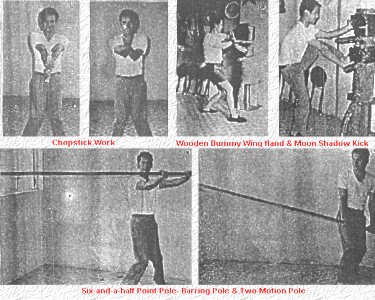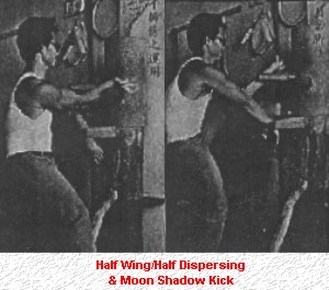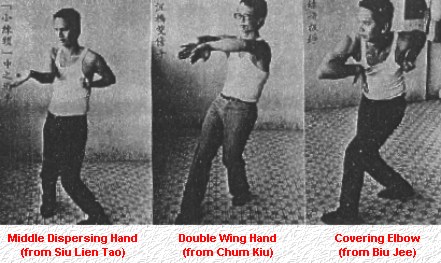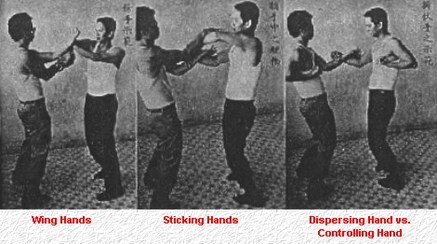Singapore Wing Chun Academy I Wing Chun Singapore
Yuen Kay San Wing Chun
By Leung Dai Chiu
From New Martial Hero, early 1970s
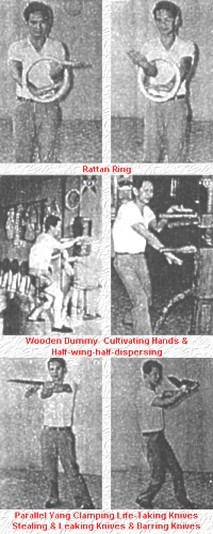
The Wing Chun system began with Ng Mui Si Tai who taught it to Yim Wing-Chun. Yim taught her husband, Leung Bok-Tao. In Foshan, Leung took a student named Wong Wah-Bo who was a member of the Red Junk Opera. Another Red Junk student, Painted Face Kam, taught Wing Chun Kuen to Fok Bo-Chuen and Fung Siu-Ching. They passed the art on to Yuen Kay-San. Yuen's nickname was Yuen Lo Jia (Yuen The Fifth) because, in his family, he was the 5th brother and in Guangdonhua, Jia signifies the 5th. Yuen Kay-San taught the art to a student named Sum who in turn taught Leung Dai-Chiu.
Leung Dai-Chiu now teaches in Kowloon and where he also runs a medical clinic and treats many specialized conditions such as falling and hitting, wind damp, and the loss of feeling children experience in their limbs. While teaching Wing Chun Boxing, Pole, and Knife, he also does a good job at medicine.
According to Yuen Kay-San grand-student Leung Dai-Chiu, Yuen Kay-San Wing Chun Kuen has forms like Siu Lien Tao (Little First Training), Chum Kiu (Sinking Bridge), Biu Jee, (Darting Fingers), Muk Yan Jong (Wooden Dummy), Sup Yee San Sik (Twelve Separate Forms), and applications.
Siu Lien Tao is the foundation form of Yuen Kay-San Wing Chun Kuen and every beginner must learn it. Its main focus is to develop the horse and bridge positions. The next form is Chum Kiu, which continues the step by step progression that allows a student to understand the methods of Wing Chun Kuen. The last form is Biu Jee, which combines the use the straight body and horse and the side body and horse together in the practice of attack and defense.
When a student has finished the Siu Lien Tao, they can use soft and hard to develop bridge feelin and strength. This is called sensitivity training. After, sticking hands involves the methods and rules from all three forms and the Sup Yee San Sik. The last stage of training is Jee Yao Pok Gik (free fighting).
After, the Muk Yan Jong is used, allowing a student to pretend they have an enemy present in training. With a classmate in chi sao, a student must be careful not to cause harm, but with a dummy more power is possible. This brings the techniques together, giving the practitioner flexibility.
In Yuen Kay-San Wing Chun Kuen, there is also a Juk Jong (Bamboo Dummy) that has twelve bamboo hands. The Juk Jong methods are all free-style, using the only the methods of Wing Chun Kuen as guidelines. The Juk Jong was used many years ago on the Red Junks. They would put bamboo arms through the cabins that had weights on the back ends. In use, they functioned like the Lien Wan Sa Bao (Linked Chain Sand Bags - a group of sand bags hung together). If a student is slow, they will be hit by the return of a previously struck arm (or sand bag).
Leung Dai-Chiu sifu explained that Yuen Kay-San Wing Chun Kuen uses the Yee Jee Kim Yeung Ma ("Yee" Shaped Groin Clamping Horse). In this, the horse clamps, the chest is hollowed, the stomach relaxed in, and the shoulders dropped. When a hand goes out, the elbow protects the chest. Each elbow can be used like half a hand, so that together, a student can employ three hands at once. The wrist is very important in the transmission of power. The gall bladder is important as the source of courage. These two allow Yuen Kay-San Wing Chun Kuen to use an opponent's own strength against him with both soft and hard.
When the arms are chambered, the body and horse should be straight. The hands should be drawn up and the elbows no allowed to be out or over the stomach. To the left and right, they should not be over the ears.
Yuen Kay-San Wing Chun Kuen uses the Twelve Methods of Join, Intercept, Sink, Dart, Stick, Feel, Steal and Leak, Swallow, Slice, Press, Swing, and Detain. Other methods for helping students practice include hitting sand bags, splitting rattan rings, twisting chopsticks, pressing paper, hitting candles, hitting telephone books, etc.
Yuen Kay-San Wing Chun Kuen uses the Luk Dim Boon Gwun (Six-and-a-Half Point Pole). It is 7'2" in Chinese measurements. The knife method is Yee Jee Kim Yeung Dit Ming Seung Do (Parallel Shaped Groing Clamping Life-Taking Double Knives).
In addition, Leung Dai-Chiu worked hard and so his teacher gave him knowledge for the treatment of falling, hitting, cuts, long-term blood stagnation, chronic pains, long-term wind damp, follow up treatment, children's lack of feeling in the extremities, rare problems, half body paralysis. This included both compresses and internal medicine, cleaning, operation, massage, and therapeutic massage.
Leung Dai-Chiu now teaches in Kowloon and where he also runs a medical clinic and treats many specialized conditions such as falling and hitting, wind damp, and the loss of feeling children experience in their limbs. While teaching Wing Chun Boxing, Pole, and Knife, he also does a good job at medicine.
According to Yuen Kay-San grand-student Leung Dai-Chiu, Yuen Kay-San Wing Chun Kuen has forms like Siu Lien Tao (Little First Training), Chum Kiu (Sinking Bridge), Biu Jee, (Darting Fingers), Muk Yan Jong (Wooden Dummy), Sup Yee San Sik (Twelve Separate Forms), and applications.
Siu Lien Tao is the foundation form of Yuen Kay-San Wing Chun Kuen and every beginner must learn it. Its main focus is to develop the horse and bridge positions. The next form is Chum Kiu, which continues the step by step progression that allows a student to understand the methods of Wing Chun Kuen. The last form is Biu Jee, which combines the use the straight body and horse and the side body and horse together in the practice of attack and defense.
When a student has finished the Siu Lien Tao, they can use soft and hard to develop bridge feelin and strength. This is called sensitivity training. After, sticking hands involves the methods and rules from all three forms and the Sup Yee San Sik. The last stage of training is Jee Yao Pok Gik (free fighting).
After, the Muk Yan Jong is used, allowing a student to pretend they have an enemy present in training. With a classmate in chi sao, a student must be careful not to cause harm, but with a dummy more power is possible. This brings the techniques together, giving the practitioner flexibility.
In Yuen Kay-San Wing Chun Kuen, there is also a Juk Jong (Bamboo Dummy) that has twelve bamboo hands. The Juk Jong methods are all free-style, using the only the methods of Wing Chun Kuen as guidelines. The Juk Jong was used many years ago on the Red Junks. They would put bamboo arms through the cabins that had weights on the back ends. In use, they functioned like the Lien Wan Sa Bao (Linked Chain Sand Bags - a group of sand bags hung together). If a student is slow, they will be hit by the return of a previously struck arm (or sand bag).
Leung Dai-Chiu sifu explained that Yuen Kay-San Wing Chun Kuen uses the Yee Jee Kim Yeung Ma ("Yee" Shaped Groin Clamping Horse). In this, the horse clamps, the chest is hollowed, the stomach relaxed in, and the shoulders dropped. When a hand goes out, the elbow protects the chest. Each elbow can be used like half a hand, so that together, a student can employ three hands at once. The wrist is very important in the transmission of power. The gall bladder is important as the source of courage. These two allow Yuen Kay-San Wing Chun Kuen to use an opponent's own strength against him with both soft and hard.
When the arms are chambered, the body and horse should be straight. The hands should be drawn up and the elbows no allowed to be out or over the stomach. To the left and right, they should not be over the ears.
Yuen Kay-San Wing Chun Kuen uses the Twelve Methods of Join, Intercept, Sink, Dart, Stick, Feel, Steal and Leak, Swallow, Slice, Press, Swing, and Detain. Other methods for helping students practice include hitting sand bags, splitting rattan rings, twisting chopsticks, pressing paper, hitting candles, hitting telephone books, etc.
Yuen Kay-San Wing Chun Kuen uses the Luk Dim Boon Gwun (Six-and-a-Half Point Pole). It is 7'2" in Chinese measurements. The knife method is Yee Jee Kim Yeung Dit Ming Seung Do (Parallel Shaped Groing Clamping Life-Taking Double Knives).
In addition, Leung Dai-Chiu worked hard and so his teacher gave him knowledge for the treatment of falling, hitting, cuts, long-term blood stagnation, chronic pains, long-term wind damp, follow up treatment, children's lack of feeling in the extremities, rare problems, half body paralysis. This included both compresses and internal medicine, cleaning, operation, massage, and therapeutic massage.
